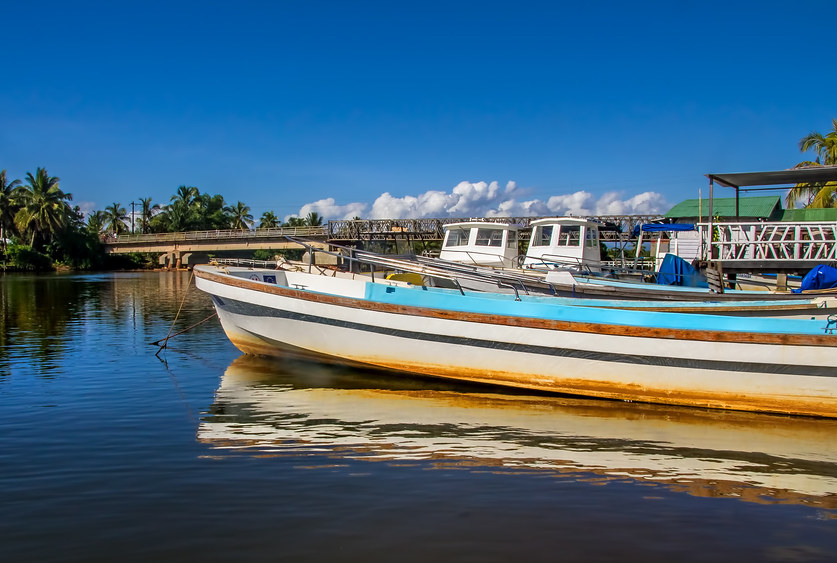Maroantsetra, which means as a Malagasy language “many spears”, is a city on the North-East of Madagascar.
It is located at the bottom of bay of Atongile between the sea and the humid and luxuriant tropical forest. The site of this city is very broken with an altitude which varies from one place to another, from 0 to 1311m. Previously, Maroantsetra was included in old the province of Toamasina; but today, it belongs to one of the great agglomerations in an area with a very evocative name: Analanjirofo, which literally means “in the middle of the clove tree forest”; here one is right in the middle of the areas where perfumes of spices and aromatic plants are absolutely exalting. The city life is measured by the cycle of vanilla and other spices or aromatic plants; a cycle which is summarized by the plantation, the gathering, the processing and especially the trade.
The road which crosses the city is decorated by many shops or displays arranged along the two sides and which expose a whole cluster of very mixed objects and goods. Like every areas of Madagascar, life in Maroantsetra is peacefully. It consequently makes it possible to offer to you a few days of relaxation, perfect rest and feeling of well being, far from your daily worries. Maroantsetra will completely make you feel strange with its luxuriant lush green and natural decoration as in the countryside. Under the murmur of coconuts tree leaves agitated by a constant sea breeze which strokes your face and the rustling of the large waves of the Indian Ocean, serenity is absolute there. This betsimisaraka city, more precisely inhabited by the antemaroa people, presents a very rich history and an immense natural treasure. The city, which is of a rather average size, is rather pleasant in spite of the time which is always unforeseeable.
The rain is always present there and it can come and go from any moment throughout the day. Even though the rain does not last long, it easily records an annual average from 3000 to 4000 m. In short, the climate of the city and area of the bay of Atongile are of hot and humid tropical type, typical for the Eastern part of Madagascar; it is regarded as the wettest area of Madagascar. Because of its favorable climatic conditions, the surroundings of Maroantsetra develop the most diversified forests, the densest and can be the richest of the Great Island. In this area, time seems to have stopped for a long time; because it did not follow the evolution, more precisely the forest degradation, which almost gangrenes the entire island. It is here that you will have the occasion to see the image of untouched Madagascar. This type of forest which becomes increasingly rare is preserved in the Masoala National park. This one is regarded as one of the largest protected area in Madagascar, which are managed by the ANGAP for the conservation of the mega-biodiversity of the island.
It covers a surface of more than 2000 km ², covered with humid forest. Maroantsetra also presents 100 km ² marine parks (Tampolo, Ambodilaitry, Ifaho) composed of the marshes and mangroves. The purpose is to protecting the coral reefs with a dazzling collection of marine species. The park of Masoala shelters ten species of lemurs of which some are endemic to the peninsula such as red ruffed lemur with blazing peeling, etc the part of Maroantsetra which offers more dazzling spectacle and more history is Nosy Mangabe located at 5 km from the coast. This small island of more than 500 ha also covered by humid forests, is classified as natural reserve. This small island is the ideal place to meet with imperceptible Aye Aye – (Daumbetonia madagascariensis). It is preferable to plan one or two nights camping out there in order to be able to seize an occasion to approach them while they feed on small insects, coconut fruit during their night hunting. They are provided with very long tentacles on its hooked and over-dimensioned middle finger.
In addition to the Aye-aye, other animal, endemic species or not, live on this island. One notes among it the mouse lemur, the smallest primate; black and white ruffed lemur; leaf tailed gecko “ Uroplatus fimbriatus”, an extraordinary endemic reptile; Endemic Phelsuma masoalensis, Masoala day geckos … The most extraordinary vegetation species of this area are the pitcher plant “nepenthes” and the “taktajania”. This small island shelters also Antimaroa clan tombs. As from the 16th century, it was successively occupied by the Portuguese, the Dutch and French. The Dutch occupation was marked by inscriptions and many installations which go back to their presence on this island. To join Maroantsetra, you can take one of the many weekly flights starting from the capital which ensure the connection. From Antananarivo, it takes one hour and thirty minutes flight before getting over the Bay of Antongil or the Cap Masoala and landing in Maroantsetra.
If you prefer more adventure, it is possible also to connect the city starting from Tamatave by wooden boats called “boutres” usually called “lakana” which make coastal traffic on the coast of the Indian Ocean. For the most enthusiastic for big thrills, one can take the highway N°5 which runs alongside the coast in the car, VTT… however it is rather risky because the road is very dubious.

